
In the Footsteps of Kate O. Sessions

Contributor
[Ed: The following is an expanded web version of Ms. Carter’s print article]
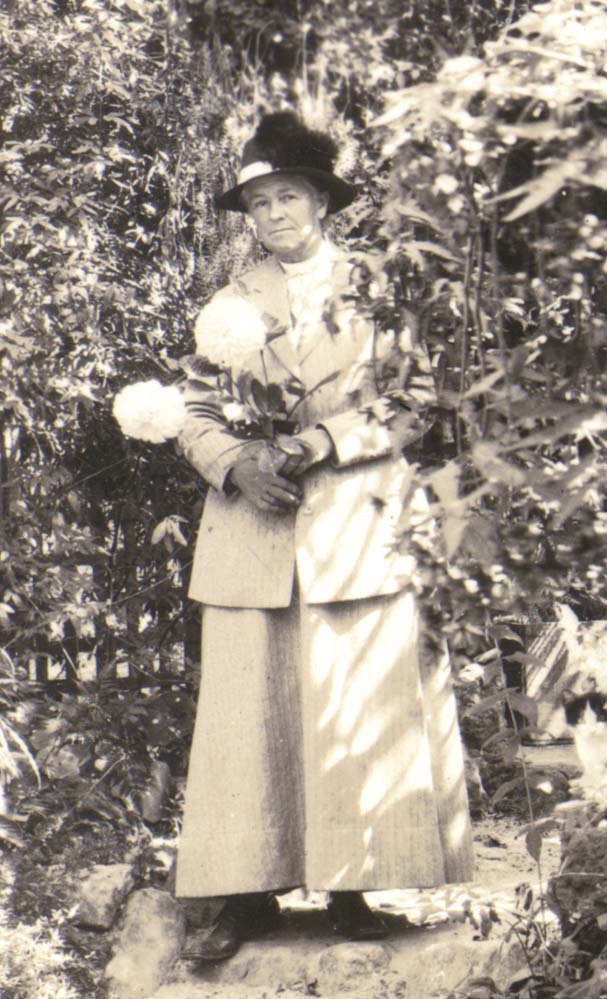
Katherine Olivia Sessions (1857–1940) enjoyed every gardener’s dream vacation in 1925. During that year, the San Diego nursery owner and horticulturist spent seven months touring gardens in Great Britain and Europe. She took in the famed Chelsea Flower Show, collected cuttings from botanical gardens, and hobnobbed with leading horticulturists from Scotland to Italy.
In long letters home, Sessions left a record of her travels with enough detail to guide a garden tour, but, after eight decades, the modern traveler would find it difficult to duplicate her experience. The sustained or recreated historical garden can approximate, but never fully duplicate an earlier iteration. Even when being consciously conserved, gardens evolve over time. Plant stock can become unobtainable and it is rare to have full sets of plans, drawings, or photographs to guide contemporary gardeners. When documentation is lacking, the recreated historical garden can be no more than an interpretation of the original.
A near-exception to these general rules is found in Sussex, just 30 miles from London and a taxi ride from Gatwick Airport or East Grinstead. The gardens and grounds of Gravetye Manor are not frozen in the past, but look very much today as they did on the occasion of Sessions’ 1925 summer visit.
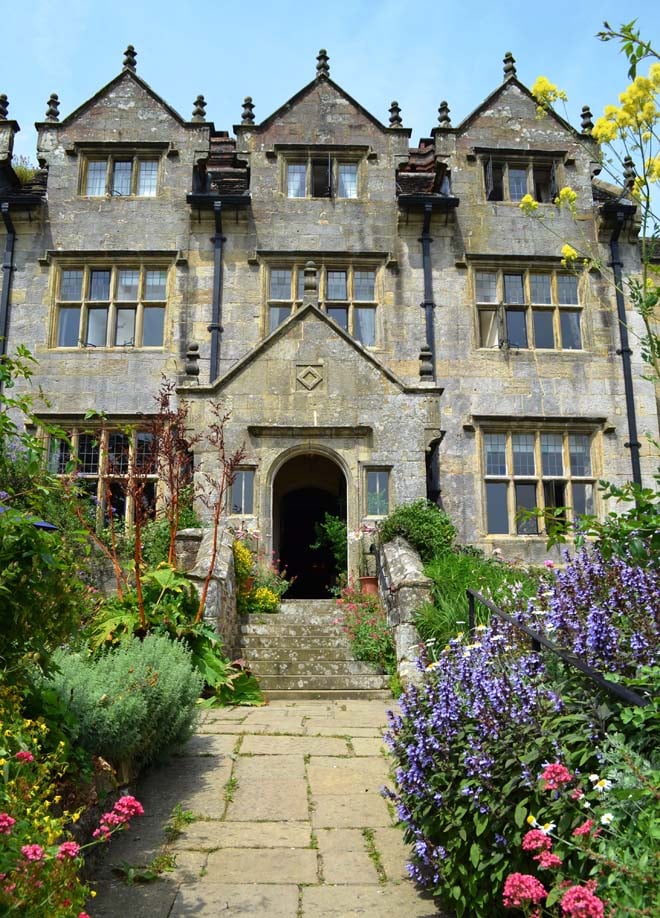
A Great British Gardener
Gravetye Manor is historically significant as the home of William Robinson (1838–1935), recognized by garden historians Mea Allan, Richard Bisgrove and others as one of Britain’s leading garden figures. Allan describes Robinson’s book The English Flower Garden as “the most widely read and influential gardening book ever written.” The work went through 15 editions in Robinson’s lifetime and is in print today. Robinson is also known for the multiple gardening journals he founded and for works on alpine flowers, garden design, French gardens, and mushroom culture. His pioneering book The Wild Garden so successfully captured evolving ideas of how gardens should look and how gardening should be practiced that it altered gardens forever. The book’s ideas are in such wide practice today that we are all Robinsonians, according to one British commentator. Bisgrove’s recent biography of Robinson emphasizes his powers as a journalist—unmatched in popularizing new ideas, but not necessarily their source. Other writers give Robinson more credit as an innovator.
With passion and an often acid pen, Robinson assailed the sacred cows of 19th-century popular landscape design. English gardens had become too transient, too fussy, too artificial, and too straight-laced for Robinson’s taste. He jeered at topiary and water features that defied gravity, disdained the clipped yew hedge, and mercilessly criticized the contrived gardens created by architects who demanded to control the appearance of the grounds surrounding their buildings. Some of his most vociferous prose condemned the Victorian garden standby of “bedding out.” Bedding called for geometric or scrolled flowerbeds to be sharply cut into lawns and seasonally filled with tender plants in elaborate designs. Among competitive gardeners, the status of these bedding schemes was enhanced by the number of rare hothouse exotics used, even if the plants had a very short life. Robinson particularly loathed “carpet bedding” in which flowers were planted to imitate Oriental rug patterns or in repetitive designs and “hideous pictures.” He pointed out that the lightest English frost could turn a hothouse plant into a puddle of black ooze. The inappropriate use of tender flowers was in his mind a form of plant torture that could be avoided by selecting hardy plants appropriate to growing conditions. Reliance on hardy plants also obviated the bedding-out problem of plaintively naked flowerbeds, left bare for weeks at a time between labor-intensive replanting.
Robinson broke away from most conventions when urging a marriage of the home and the garden and compatibility between the garden and its natural setting. While by no means abandoning all structure in the garden, Robinson believed in situational design rather than the imposition of a “stereotyped style.” He advocated the retention of natural land levels and planting in irregular drifts of color, rather than regimented designs.
Most significantly, he helped generations of gardeners develop an appreciation for native and hardy perennial plants. His endorsement of more naturalistic garden styles using indigenous plant material won favor with those in the aesthetic backlash against harsh British industrialization. Disciples of social critics John Ruskin and William Morris easily gravitated to the ideas of Robinson, adapting his principles to gardens of all sizes. These broader aspects of Robinson’s success continue to be recognized today. Judith B. Tankard writes about the recognition of the landscape created at Gravetye Manor as an icon of arts and crafts gardening in Gardens of the Arts and Crafts Movement: Reality and Imagination, 2004.
Much earlier, in 1896, Gertrude Jekyll, another English garden master, proclaimed Robinson’s success in regard to overly formal planting. The bedding system was virtually dead she wrote in her testimonial, “The Idea of a Garden,” due to Robinson’s life work to “overthrow [its] feeble follies.” She credited “his unremitting labours” for bringing to all gardeners a clear knowledge of hardy plant beauty. By stating that bedding was virtually dead, Jekyll acknowledges some continued use and, in fact, both Jekyll and Robinson might be dismayed by the stubborn persistence of the practice. Hothouse plants are still set out in elaborate designs in many English public gardens and parks, but Robinson and his early notions of sustainability did bring an end to bedding out as the obligatory competitive sport of home gardeners.

An Irish immigrant without wealth or connections in England, Robinson employed talent and hard work to transcend 19th-century constraints on social and economic mobility. He became both famous and wealthy from his work in horticulture. Shrewd investments improved his finances sufficiently to allow the 1885 purchase of Gravetye Manor, a 360-acre estate in the Sussex countryside outside London. Robinson thought the landscaping dreadful, but the house, built in 1598, was large and beautiful. This estate presented the perfect canvas for creating his own first garden.
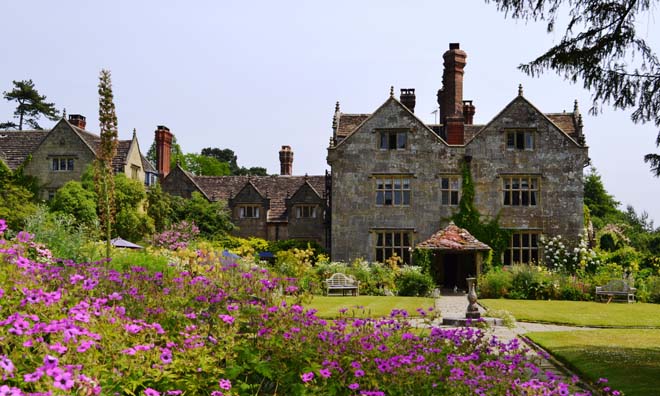 The next 50-years of Robinson’s long life were spent at Gravetye Manor breathing life into the garden ideas he had previously captured only on paper. He surrounded his home with formal and informal gardens, including a memorable rose garden and woodlands filled with wildflowers and planted bulbs. In 1904 he set out more than 50,000 narcissus in the pasture, woods, and orchard around Gravetye. He purchased adjacent land and eventually dedicated more than 500 acres to forest. In one two-year period, he planted 120,000 trees, including American species sent by Frederick Law Olmstead, the Superintendent of Central Park in New York. Robinson documented work on the gardens and grounds with photographs and careful records. Much of this information is captured in Gravetye Manor: or, Twenty Years Work Around an Old Manor House… privately published by Robinson in 1911. He also hosted several artists who spent months in residence while painting Gravetye and its gardens.
The next 50-years of Robinson’s long life were spent at Gravetye Manor breathing life into the garden ideas he had previously captured only on paper. He surrounded his home with formal and informal gardens, including a memorable rose garden and woodlands filled with wildflowers and planted bulbs. In 1904 he set out more than 50,000 narcissus in the pasture, woods, and orchard around Gravetye. He purchased adjacent land and eventually dedicated more than 500 acres to forest. In one two-year period, he planted 120,000 trees, including American species sent by Frederick Law Olmstead, the Superintendent of Central Park in New York. Robinson documented work on the gardens and grounds with photographs and careful records. Much of this information is captured in Gravetye Manor: or, Twenty Years Work Around an Old Manor House… privately published by Robinson in 1911. He also hosted several artists who spent months in residence while painting Gravetye and its gardens.
Miss Sessions Comes to Call
Kate Sessions was a student of horticulture and corresponded with an international network of botanists, gardeners and growers. One of her closest personal and professional friends in San Diego was an English immigrant and enthusiastic gardener. Through these contacts and her own reading, she is very likely to have been familiar with William Robinson’s writing and ideas, but any early writings she may have done on Robinson have not come to light.
Sessions unquestionably read about Robinson in the July and August 1924 issues of California Garden magazine (Volume 16, Numbers 1 and 2). She wrote for this San Diego Floral Association publication and devoured every issue. The July number carried James Wilkinson Elliott’s (1858–1939) first-hand account of his visit to Robinson and Gravetye Manor, a glowing account of Robinson’s career, and a rave review of The English Flower Garden (first appearing in 1883, the work was already in multiple editions and well-established as the Bible of British gardening). Elliott was a Pennsylvania nursery operator, horticulturist and occasional landscape architect and author who retired to San Diego in 1923.
In August 1924, California Garden editorialized that Robinson’s The English Flower Garden had useful lessons for local landscape choices, particularly the notion of using native plants and selecting a garden style appropriate to the setting. As applied to San Diego, the editor noted, this would mean a move away from water-hungry grass lawns.
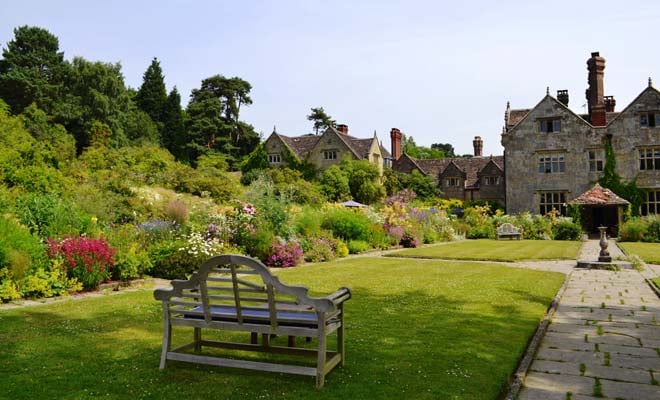
When Sessions went to England in 1925, she had an introduction to Robinson through James Wilkinson Elliott and was invited to lunch at Gravetye Manor. Among the handful of personal letters found in the scant collections of Kate Sessions papers is a handwritten note from Robinson on Gravetye Manor stationery, confirming her luncheon visit and offering suggestions on transportation. While not lacking in sophistication, Sessions must have been awed when she arrived at this large stone Elizabethan country mansion with its diamond-mullioned windows and multiple chimneys. Robinson refused to burn dirty coal, so every room featured a large wood-burning fireplace, along with mellow oak paneling and plaster ceilings embellished with leaf and flower designs.
It is intriguing to imagine the exchange between these two highly opinionated, plainspoken, self-made, and practical gardeners whose combined experience represented more than a century of single-minded devotion to horticulture (both having shunned marriage and conventional family life). Robinson’s travels in California years earlier perhaps offered a starting point for conversation. His most enthusiastic writing about a 1870 visit to the United States dwelt on Yosemite Valley and the beauty of California’s forests. Kate Sessions was born in San Francisco, lived in Oakland, and graduated from the University of California at Berkeley. She could hold up her end of a conversation about Northern California, but the conversation surely moved quickly to horticulture where they shared so much common ground.
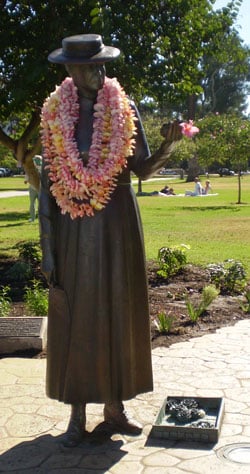
These two gardeners both loved flowers and vines and were attentive to the natural form and beauty of plants. A focus on the individual nature of plants informed all their gardening ideas and was an outlet for sentiment. Kate Sessions once called flowers “her children,” while Robinson had compared the bedding out of tender plants a torture, analogous to sending child laborers into dangerous factories. Both were advocates of wildflower preservation and using native plants in created landscapes, but they agreed that horticulturists should experiment with imported species to learn which were hardy in a new setting. They favored naturalistic planting styles and had no sympathy with the overly formal garden styles of the past. Both Sessions and Robinson ardently practiced and preached forestation. Each was a garden journalist, although only Robinson made it a full-time entrepreneurial endeavor.
Among the many possible topics they may have discussed over lunch, we know with certainty about just two. Upon sitting at the dining table, Sessions expressed delight with the centerpiece. It was the first time she had seen full-blown roses floated in a low bowl. She told her host that she would introduce this kind of rose display to San Diego (according to her biographer, Elizabeth MacPhail, Sessions did so, calling it the “William Robinson bouquet”). Secondly, Sessions discussed her purchase in London of a run of Robinson’s most successful journal, Gardening Illustrated, which was unfortunately missing some issues. On the spot, Robinson offered to sell her 56 complete volumes from his personal collection. With this business concluded, Sessions was placed in the hands of Robinson’s head gardener for a tour of the estate grounds. By this time he was wheelchair-bound due to crippling arthritis.
Sessions described her visit to Gravetye Manor in a letter published in the San Diego Union newspaper and an article in the November 1925 issue of California Garden. She admired the woodlands at Gravetye and the intelligent placement and care of other plants “for the best results.” She compared the heathers with the South African varieties she was growing in San Diego and commented on the fine condition of the berries, vegetables, and fruit. Robinson’s design theories had influenced English gardens, Sessions observed, and San Diegans would do well to follow his advice on employing “more naturalistic planting.” Robinson’s keen interest and engagement in his estate lands, even at age 85, prompted Sessions to advise that an interest in growing things and a habit of gardening, particularly in San Diego, were a recipe for health, joy, and longevity.
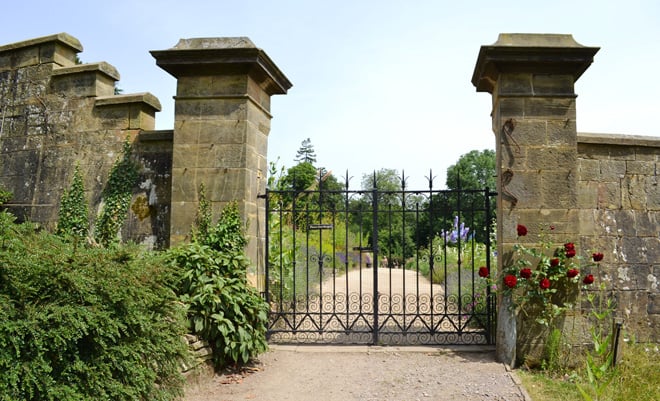
An Afterlife for Gravetye Manor
William Robinson enjoyed just one more decade at Gravetye Manor after Kate Session’s visit. He died in 1935 at age 96, leaving Gravetye Manor to the nation to be held and used for forestry. The house was to be rented out, and the woodlands preserved as a bird and animal sanctuary (Gravetye’s woodlands are still managed as part of Britain’s national forests).
Fulfillment of the terms of Robinson’s bequest was complicated by the radical, social, and economic changes in England during the interlude between World Wars I and II; after the First World War, it became much more difficult to hire the large staffs required to maintain country estates. With a sharp reduction in the number and skill of its gardeners, the cultivated grounds at Gravetye were soon neglected and overgrown. The house was vacant for four years after Robinson’s death. When it was finally leased in 1939, five gardeners were hired to restore the grounds. When World War II broke out that same year, all the gardeners were drafted into military service and the manor house was requisitioned as a billet for Canadian military officers. After 1945, Gravetye had a series of tenants and periodically stood vacant.
For two decades after his death, Robinson’s horticultural achievement at Gravetye Manor was severely diminished. The year 1958 was a turning point. The estate was leased for development as a country hotel with Peter Herbert as the managing director. Herbert relied on Robinson’s original documentation and photographs to undertake a conscientious and respectful restoration of the famous gardens. The grounds slowly reclaimed the natural elegance that had charmed Kate Sessions more than 30 years earlier. While not slavish to every aspect of Robinson’s design, or limited to his pre-1935 plant choices, the restored gardens at Gravetye Manor are today considered a “model of natural planting and one of the most convincing testaments to Robinson’s reforming convictions.” (Wendy Hitchmough, Arts and Crafts Gardens, 2005).
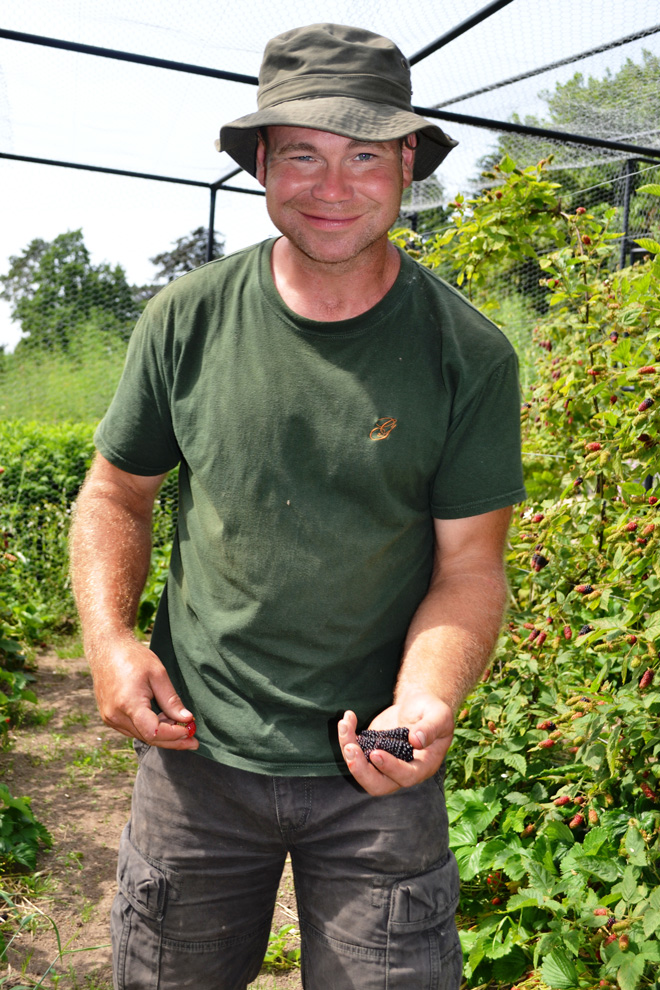
A different owner took over the hotel operation in 2010 and a talented new gardener came to Gravetye Manor the following year from the renowned garden at Great Dixter. The two are implementing a five-year plan to bring greater integrity and more exacting horticultural care to William Robinson’s garden creation. The results so far are entrancing. The mixed borders and flower gardens near the manor house and the meadow between the house and the lakes are beautiful, but the elliptical walled garden is alone worth a visit to Gravetye.
Robinson reinvented the rectangular English kitchen garden with the construction of a huge oval-shaped enclosed garden entered through decorative iron gates. Robinson would surely approve of the planning, maintenance and productivity evident today within the microclimate of his tall curved walls. Using a sophisticated six-bed rotation system, vegetables and cutting flowers are grown for the hotel, with chickens as part of the rotation. Strawberries, raspberries, blackberries and gooseberries are protected from marauders by a large mesh enclosure at one side of the garden. Fruit trees are grown in the open and espaliered on walls. There is a sunken stone watercress pond. While orderly and practical, this garden is lovely to look at and comfortable to visit. A wide oval crushed gravel path circumnavigates the entire garden. Robinson’s darkly mature conifer plantings rise into view over the walls. In the quiet country air, the sounds of birds and bees seem highly amplified. The initials “WR” are inscribed in stone over a shaded bench. Across the garden and near another bench, an antique Venetian wellhead given to Robinson in 1922 marks “the spring which has supplied Gravetye Manor for centuries,” reminding the visitor that this house and its first gardens were built when Elizabeth I sat on the English throne.
Gravetye Manor
Gravetye Manor is located on Vowels Lane, West Hoathly, Sussex, RH194LJ
For an online video presentation on the gardens, commentary by gardener Tom Coward and information about staying or dining at Gravetye Manor, visit: www.gravetyemanor.co.uk
Today at Gravetye Manor, the contemporary traveler can see a house, still beautiful and vibrantly useful after almost 500 years, and some of England’s most famous gardens, looking very much as they did when Kate Sessions ventured out from London to have lunch with William Robinson on June 26, 1925. Alas, there is no free lunch for the visitor. Gravetye Manor is open to paying guests who wish to enjoy a luxurious country hotel with an acclaimed restaurant.
Share:
Social Media
Garden Futurist Podcast
Most Popular
Videos
Topics
Related Posts

Low Maintenance Gardens – Better for Pollinators and People
Autumn 2022 “I come out every day. It’s therapy, my meditation.” Janet’s young garden transformed from overgrown, invasive plants to mostly natives. The dailiness of

Invasive Plants Are Still Being Sold: Preventing Noxious Weeds in Your Landscape
Autumn 2022 With so many beautiful ornamental plant species and cultivars throughout California and the Pacific Northwest, how do you decide which ones to include

Garden Design in Steppe with Transforming Landscapes with Garden Futurist Emmanuel Didier
Summer 2022 Listen to full Garden Futurist: Episode XVII podcast here. Emmanuel Didier, Principal and Creative Director at Didier Design Studio is a leading figure
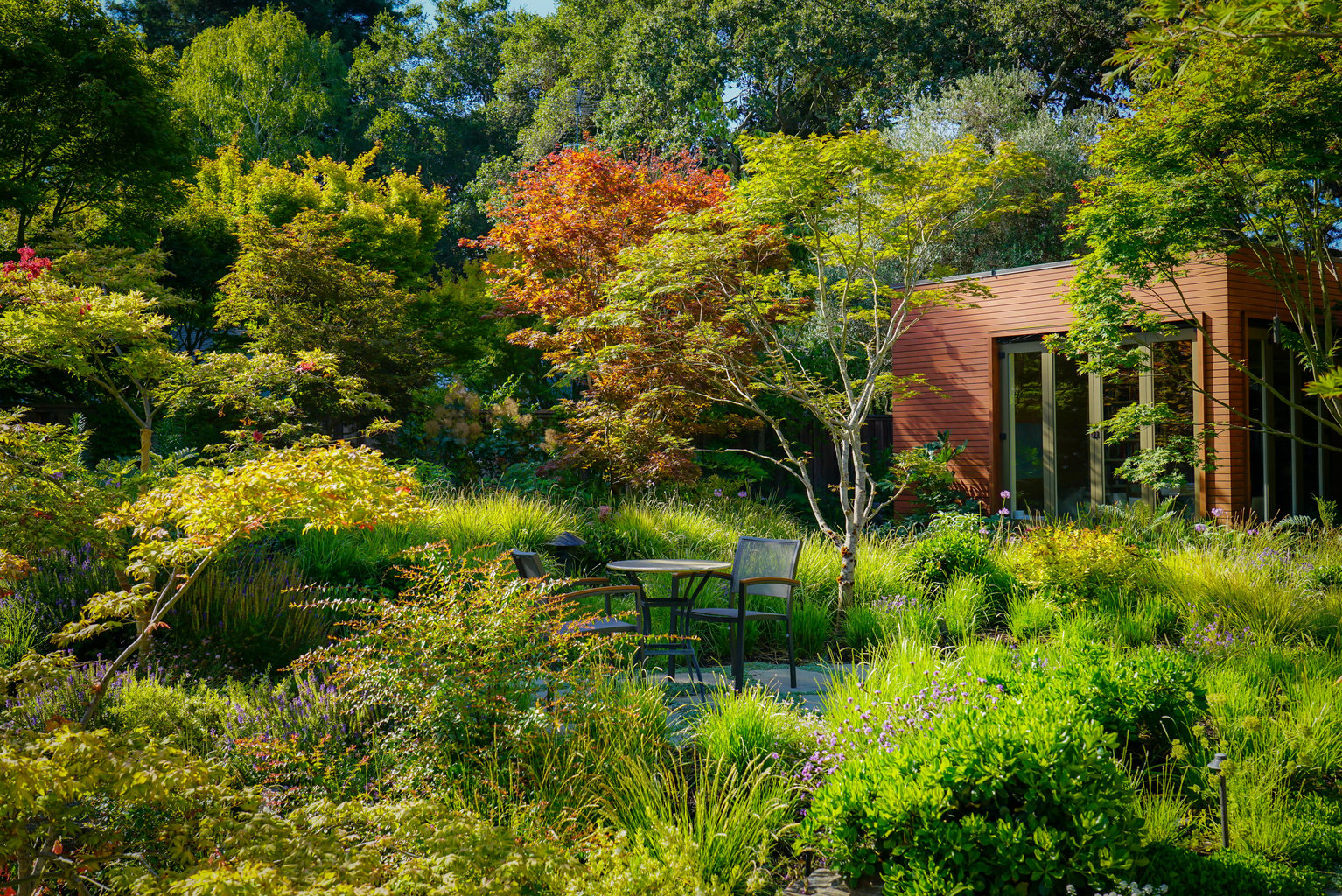
Seslerias: Versatile Groundcover Meadow Grasses
Summer 2022 Without question, the most beautiful and versatile of all the groundcover meadow grasses are the moor grasses (Sesleria). Moor grasses tick off all










Responses